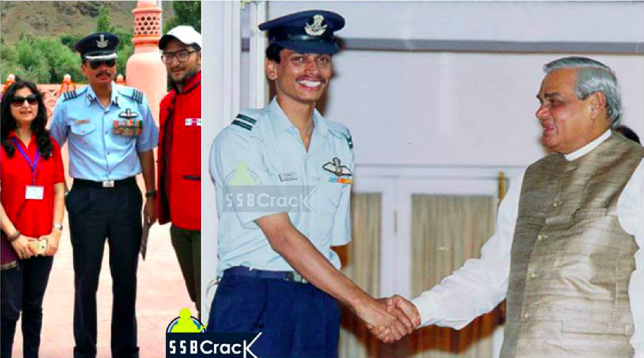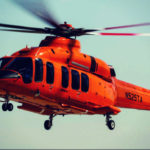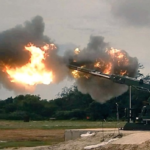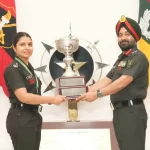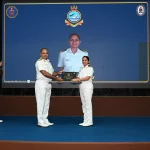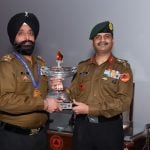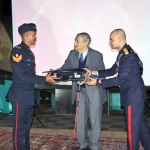Group Captain Kambampati Nachiketa, Vayusena Medal (Gallantry), is a serving officer of the Indian Air Force. Group Captain Nachiketa came into the limelight during the Kargil War when on 27 May 1999, as a Flight Lieutenant, he was captured by Pakistani troops in Kashmir following ejection from his MiG-27L.
The MiG-27 fighter aircraft flew by Flight Lieutenant K Nachiketa was shot down by the Pakistan Army during the 1999 Kargil conflict.
Here is his story:
During the Kargil War in 1999, K Nachiketa was a 26-year-old fighter pilot assigned the task of hitting Pakistani posts in Kargil at altitudes in excess of 17,000 feet. He had locked on to a target and fired the powerful cannon of his MiG 27 fighter bomber when he experienced a nightmare for a pilot anywhere. His engine “flamed out” – it went dead, mid-air. Training took over and to get the engine restarted was his only goal.
He had a technical problem with the engine; his engine shut and he had to re-ignite. But you have to be flying at a certain height before you can do so. In his case, since he was flying over a terrain of five plus km, he did not have the adequate height. As a result, he had to eject.
The last words that his colleagues heard before he faded out were: ” Nachi – engine flame-out, relighting…. Nachi ejecting now.” and then an ominous silence. As Nachiketa parachuted down the dark ragged edges of the snow-clad mountains, the sky was lit a brilliant red by the giant explosion of his hapless aircraft. And then suddenly as he landed on the rocky surface, Nachiketa observed a speck in the sky. It was his fellow pilot, a daredevil squadron leader by the name of Ajay Ahuja, hovering over in his MiG-21 straining his eyes to catch sight of the landing area of his colleague.
Suddenly an explosion reverberated across the horizon, as Nachiketa recoiled in horror. A missile from the Afghani Mujahideen stockpile found its mark and hit Ahuja’s plane. Ahuja frantically radioed his team leader Hercules one, “missile hit” his voice crackled and then again a deathly silence.
About two to three hours after Nachiketa ejected, he was ambushed and there was a firefight. Regular Pakistani Army troops fired at him, he fired back. Eventually, he was captured because he was outnumbered. He had one pistol against five-six AK-56s.
The soldiers of the Pakistani Northern Light Infantry who captured him were brutal, beating him badly till a senior officer emerged and ordered his men to back off. As he explains the situation, “The jawans who had captured me were trying to manhandle me and maybe trying to kill me, because, for them, I was just an enemy pilot who had fired on their locations from the air. And on-ground, I was firing at them. Fortunately, the officer who came was very mature. He realised the situation that I am now a captive and now I need not be handled that way. So he was able to control them, which was a big effort because they were very aggressive at that stage.”
After about a two-hour halt at a place in the Batalik sector, he was taken by a helicopter to Skardu. After a night halt, he was shifted to Rawalpindi. He stayed there for four days.
When enquired about how his captors treated him, he said:
”They took it in two phases. First, they declared me uncooperative. Then it became quite bad. I don’t want to go into the specifics. They asked me about our forces, their deployment, the kind of avionics and ammunition that we have.
He didn’t even expect himself to come back home safely:
“As per our background, from 1971 what we have seen, no one generally comes back,” he said explaining the experience that “It was very tough. I can’t describe that experience in words. That time I thought maybe death is a simpler solution. But I am thankful to god that destiny was on my side. I underwent severe mental and physical torture there for three-four days.”
Thereafter a decision to release him was taken and he came back via the Wagah border. He was later handed over to Indian authorities at the Wagah border following mounting pressure from the UN and international media.
Nachiketa is one of the very few IAF pilots to have returned after their aircraft crashed in enemy territory. He was shot down on May 28, 1999, and held in captivity before being released a week later on June 4. He was later diagnosed with a back problem – a compression fracture – which meant he could never fly fighters again.
Many thought his flying days were over due to a spinal injury he sustained while ejecting from his MiG-27 fighter – but he has proved the skeptics wrong.
17 years after Kargil, Nachi believes that “The heart of a pilot is always in the cockpit.” Nachiketa is now a Group Captain and flies Ilyushin Il-78 mid-air refuelling transport aircraft with No. 78 Squadron IAF stationed at Agra. He was transferred to transports due to injuries he sustained during para-landing.
However, after a series of remedial measures and retraining, he has been flying AN-24s since 2004 and is currently posted with the Chandigarh-based 48 Squadron.

